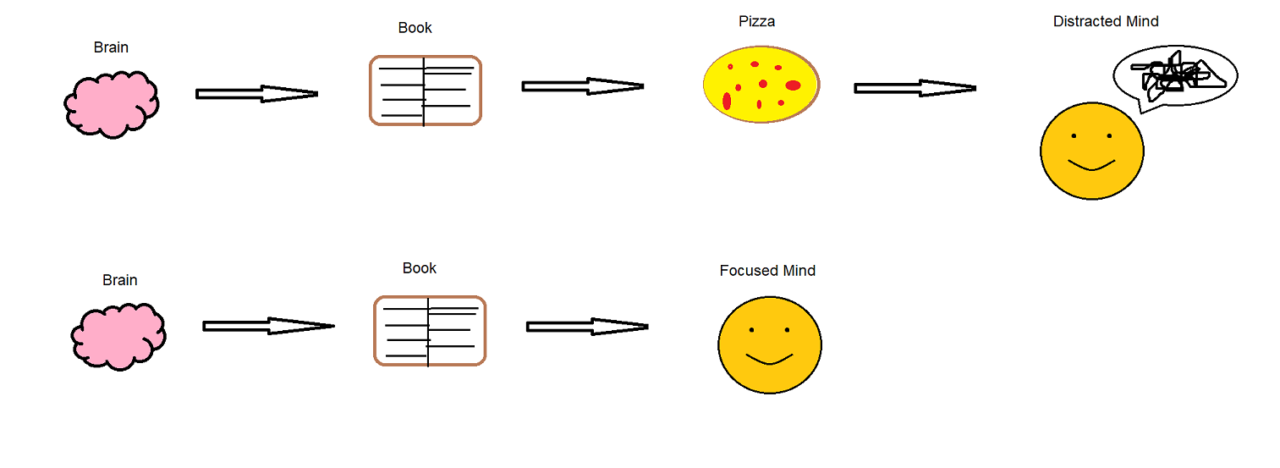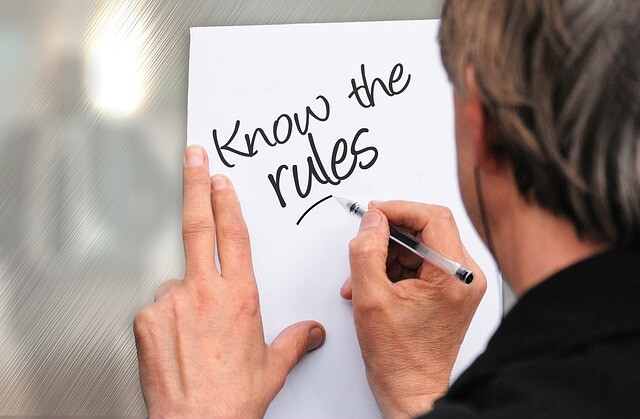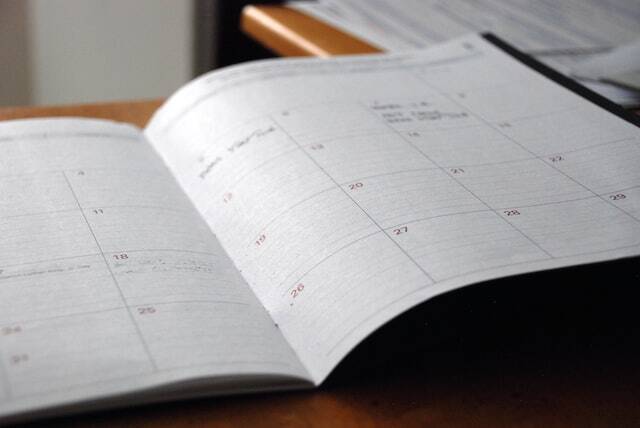This article serves as a comprehensive guide; it covers everything you need to know to get straight A’s in high school.
I based this guide on my 10+ years of college admissions consulting, educational advising, and private tutoring.
I also borrowed ideas from fellow colleagues working in children’s and adult psychology as well as some of my own personal research on classroom methodologies and learning disabilities.
Long story short: I’ve done my homework on this topic!
Although this guide was written specifically with high schoolers in mind, these rules are also applicable to people of all backgrounds.
I’ve used these rules to help students both in high school and in college get straight A’s over a short period of time. (Typically within 2-5 quarters)
But, before we get started, a word of warning. There are 12 sections to this complete tutorial.
“Geez,” you may ask, “12 whole sections?!”
Yeah, we get it. It’s long.
Getting straight A’s in high school isn’t a walk in the park. There are a lot of rules and exceptions and rules on exceptions. That’s why our guide has 12 whole sections; and, even then, it’s impossible to cover everything. That’s why some of the guides you see online that talk about how to get straight A’s in high school often don’t help. They’re too simple and short!
They don’t cover EVERYTHING you need to know.
So: please, please, please read through this entire article and do not skip through any of the 12 points we’ve listed below.
I know, it’s a long read. But, seriously. Even if you skim through our article, where would that lack of patience get you?
Nowhere near straight A’s that’s for sure!
So, get a pen and a piece of paper and get ready to start taking notes. Got it? Great! Let’s start with the first point.
Professional College Application Help.
Contact us. We'll get to you within 24 hours.
- Beware of Useless School Advice.
- Get Tested for ADHD, Fluid Intelligence, Crystalized Intelligence, Big 5 Personality Traits, and Other Important Variables.
- Get Organized… Seriously.
- Rewire Your Dopamine Sensitivity.
- Sometimes, Your Teachers Are Your Best Tool. Other Times, They Just Don’t Give an F.
- Forget Everything You Know About Motivation. You Won’t Work Hard With Motivation.
- Take the Right Classes. (Yes, There are Right and Wrong Ones)
- Pace Yourself. (Correctly)
- Train Yourself to Follow the Rules You Make for Yourself.
- Create a Customized Work Plan.
- Document BOTH Your Strengths and Weaknesses.
- Don’t Use Tutors; Instead, Use Coaches.
Beware of Useless School Advice.

We cannot stress this enough.
To earn straight A’s in high school, avoid useless school advice.
This is because most online school advice isn’t very helpful.
Sometimes bad advice falls through the cracks. That’s fine. However, most advice from social media, parents, adults, peers and even other teachers and tutors is wrong. Sometimes it’s even fatally wrong.
Here’s an example.

What’s wrong with the visual above?
It looks pretty, smart, and positive. Right?
That’s true. However, advice like this often does NOT actually help students increase their academic performance. Let’s take a look deeper at why this content doesn’t work. We’ve pasted the contents of the example visual below.
Do
- Forgive yourself
- Pace yourself
- Pay attention in class
- Sit in the front of the class
- Ask the teacher for help
- Take notes
- Be positive
Don’t
- Push yourself too hard
- Procrastinate
- Fall asleep in class
- Sit in the back of the class
- Rely only on yourself
- Try to memorize everything
- Be pessimistic
If you observe these points and think about it for a bit, you’ll actually notice that this is not advice at all.
In fact, these are actually observations of what someone “ought” to be rather than executive functions.
Let’s take the “don’t procrastinate” advice for instance.
When people say “don’t procrastinate”, they don’t realize that that’s not an actionable command.
On the other hand, this advice works:
“Avoid procrastinating by setting personal boundaries with your own actions, alternating between tasks in 15-minute intervals, and reducing exposure to highly-stimulating activities and environments.”
The difference between the two is that one provides a surface-level command with no actionable tasks, and the other provides clear instructions to follow.
A good way to remember this is to think of how people gain and lose weight.
You can tell someone “Calories in and calories out.” But, that advice doesn’t work without also giving instructions such as, “learn to count said calories, read nutritional labels, follow a push-pull-leg routine, and keep your nutritional intake organized through a planner or calendar.
By providing actionable advice on how to achieve certain results, you’ll have proper steps to follow that will lead you to earn straight A’s in high school.
Get Tested for ADHD, Fluid Intelligence, Crystalized Intelligence, Big 5 Personality, and Other Important Variables.

“Woah! Isn’t this too much?” you may ask.
The answer is: no.
No, this is just the right amount of testing we heavily advise you to take. It DOES NOT MATTER if you or your child are neurotypical or don’t seem to have anything wrong academically or mentally. These tests provide CRUCIAL information that can make or break your path toward getting straight A’s in high school.
Now, why is that? Why do we even need to test for this stuff? Why is it such a big deal? Can’t we just study more and cross our fingers for straight A’s?
Well, not really.
These tests are crucial because the factors they screen for play a massive role in academic performance. One variable that is severely incongruent with the average can explain exactly why earning straight A’s is so difficult.
We often give these sets of tests to clients of ours who have talented kids who are very bright but earning low grades. One of the most common issues they have is high levels of fluid and crystallized intelligence. But, their ADHD gets in the way of their ability to focus in class or even complete basic assignments.
By taking tests to measure your or your child’s levels of ADHD, fluid intelligence, crystallized intelligence, and Big 5 personality traits, you can check to make sure no unusual circumstances may be making straight A’s more difficult than necessary.
Let’s walk through each of these.
Note: if you need help looking for a low-cost provider for these tests, feel free to ask us for help through our contact form. We are happy to give you recommendations on tests that would best suit you or your child.
ADHD
According to the CDC, ADHD is…
“…one of the most common neurodevelopmental disorders of childhood. It is usually first diagnosed in childhood and often lasts into adulthood. Children with ADHD may have trouble paying attention, controlling impulsive behaviors (may act without thinking about what the result will be), or be overly active.”
Center for Disease Control and Prevention Official Website
It’s important to check if you or your child has ADHD because it can have drastic changes to your ability to perform in academics. The tricky part is that everyone goes through ADHD differently. In addition, many people show different symptoms which may make ADHD hard to detect.
So, how much of an impact does ADHD have on academic performance? According to an article in the National Library of Medicine, ADHD often has negative effects on academic performance. (duh!) Medication had positive effects, but sometimes mixed results. And, sometimes there are mixed results. Ultimately, though, identifying the condition and treating it seems to be a net positive.
Based on some of the students I’ve seen and some of the transcripts I’ve seen from previous clients who were applying to college with ADHD, this is the most common pattern of academic performance we see in students who have ADHD.

In the first pattern, students often have a decreasing GPA that forces them to resort to drastic measures. This includes pressuring oneself very hard on bursts of energy that temporarily give GPA boosts. However, after the third year, burnout ensues and the GPA tanks even further.
So, they work super hard. Then, burnout. Despite the GPA increasing a bit, it tanks further over time.
However, there are those with ADHD who actually perform differently than this. This is the second most common pattern. Check it out below.

Notice how in the second pattern the GPA actually starts off quite high? This pattern is what we call the “Gifted Burnout Pattern.”
This is because, well, as the name of the pattern states, students who are often gifted also happen to show this pattern of GPA decrease over time.
Now, why is that?
Well, gifted students often perform well not because they developed the right learning and study habits. They often breeze through school without trying because they were smart enough to learn content in class quickly in order to pass tests with ease. This is also why these students often don’t complete their homework; but, they can study for five minutes before a test and still earn an A.
But, over time, as the content in high school gets harder, they can no longer rely on their smart brains to get by. They need to study and truly learn to earn straight A’s in high school. However, they cannot start to learn how to study on their own in a few weeks, as it takes years of practice to truly learn how to study and retain information. So, their academic performance tanks along with their self-esteem, ultimately leading to a positive feedback loop of low performance and self-denigration.
This is why getting tested is absolutely crucial to making sure your getting straight As in high school the RIGHT way. If you don’t realize you have ADHD and you work your way to a higher grade without understanding your condition, you’re setting yourself up for failure.
Okay, now for the good stuff. Let’s talk about how much this will cost.
Testing for ADHD can cost a pretty penny; but, it’s infinitely worth it for those who want to have a better understanding of their learning ability and how they should go about earning straight A’s in high school.
ADHD tests often employ computerized tests like the ATA, CPT3, and CATA; in addition, you’ll be paying for the psychologist’s time. So, ADHD tests on average can cost the following.
“The minimal average price is $295-$375 and a comprehensive evaluation could run you $3,700-$4,500. In this article, we will go over the cost of an ADHD evaluation, factors that can influence the cost, and what to expect during an ADHD evaluation.”
Joonapp.io —Dr. Carrie Jackson, PhD Licensed Child Psychologist
Keep in mind that alongside an ADHD test, psychologists providing the diagnosis often will provide an IQ test along with it. We highly recommend you follow through with both tests, as they measure both crystallized and fluid intelligence.
If you want to get tested for ADHD but don’t know whom to speak to or which psychologist to work with, feel free to contact us! We’ve helped applicants with their academics, and this includes referring them to the right professionals!
Fluid Intelligence
Fluid intelligence is defined by the following:
“”The ability to perceive relationships independent of previous specific practice or instruction concerning those relationships.”
Raymond B.Cattell —Age differences in fluid and crystallized intelligence
So, in simpler terms, fluid intelligence is about your ability to solve and work with new information presented to you. In very broad terms, this involves comprehension, reasoning, and problem-solving.
There are many tests out there you can take to accurately measure fluid intelligence. Preferably, you would not use a for-fun surface-level test like the ones you’d find on Buzzfeed or other non-efficacious applications of testing.
Here at PenningPapers, there are three tests we recommend you take to measure fluid intelligence. You don’t have to do all three. But, we suggest at least one.
- Woodcock-Johnson Test of Cognitive Abilities
- Raven’s Progressive Matrices
- Wesschler Intelligence Scale for Children
Now, this may be our bias due to the kinds of clients we get, but we highly recommend you take the Raven’s Progressive Matrices test out of the three. There are two reasons for this.
- The Raven’s Matrices test is economically friendly to take.
- The test works for all students regardless of communication, physical, motor, cultural, and language obstacles. This makes the test versatile and applicable to most if not all students.
So, if you take a test for fluid intelligence, what are you really looking for? Well, you may initially want to be at the 99th percentile. But, you really don’t have to. That’s the thing. You don’t have to be born a super genius in order to get straight As in high school.
Preferably, you want to be at least in the median range of fluid intelligence.
Crystallized Intelligence
Crystallized intelligence is defined as the following.
“General crystallized intelligence (Gc), or crystallized intelligence, is information you’ve learned in the past and stored. Gc results from experience, education, and cultural background.
School testing of learned facts and job candidate testing of software knowledge are examples of crystallized knowledge assessments.”
Psych Central —How We Use Fluid vs. Crystallized Intelligence
Again, in simpler terms: crystallized intelligence involves recalling knowledge that you already have. Then, apply said old knowledge or experiences to new situations.
In addition, crystallized intelligence was found to be more significant in impact to academic performance, as mentioned by Bennett Eugene Postlethwaite’s article.
Keep in mind that crystallized intelligence works alongside fluid intelligence to help you problem-solve. This works in conjunction with working memory and processing speed to ultimately give you IQ.
So, the problem-solving abilities that you’ll use in school are majorly affected by IQ, which consists of the following.
- Fluid intelligence
- Crystallized intelligence
- Working memory
- Processing speed.
Although truly measuring crystallized intelligence can be unfair, especially for questions that are beyond your known frame of reference, you can take a general intelligence test (IQ Test) to measure all four of these elements.
However, genuinely accurate IQ tests can be a bit pricey.
The best IQ tests that measure everything with the highest accuracy often require a licensed psychologist proctoring the test as well; so, the cost can be anywhere between free to 1,500 USD.
Oftentimes, if you take a test for ADHD, a full-scale IQ test will be recommended alongside it. So, you can get both measurements done in one go.
Big 5 Personality Traits
This is actually quite a simple one. And, unlike a comprehensive test that involves both ADHD and IQ testing, this is quite easy and cost-effective.
The big 5 personality test measures exactly what its name suggests: 5 big traits that constitute our general personality.
These 5 traits are separated into the following
- Openness
- Trait creativeness, thoughts in abstraction
- Conscientiousness
- Dutifulness and hard-working; it’s sometimes correlated with disgust sensitivity (weirdly enough)
- Extraversion
- Enthusiasm, sociability, (sometimes mixed in with impulsivity depending on the test)
- Agreeableness
- Empathy, altruism, and a necessity for social harmony (think smoothing the waters and avoiding unnecessary conflict)
- Neuroticism
- proclivities toward negative or unstable emotions
Now, each of these 5 variables can have a massive impact on how easily you can get straight A’s in high school or improve your academic performance in general.
First, let’s cover Openness.
Openness is generally your trait of creativity and general openness to new experiences. This is often a characteristic favored and glamorized in academic settings. “Be creative!” and “Open your creative mind!” are often slogans used in motivational posters as well as often touted by teachers and administrators in educational settings. But, openness can sometimes have a negative impact on academic performance depending on how often students stray from the frame of measurable assignments. For example, sometimes student creativity makes them go against the directions in assignments and therefore score poorly —after all, schools were designed in some ways to reward those who stay within the confines of their designated assignments and directions.
Conscientiousness is just as it sounds. The proclivity to hard work. This is one of the most important elements of personality that contribute to academic performance. Conscientiousness is not the same as the act of doing hard work. It’s the personality trait of preferring to do hard work and needing to keep your hands busy with some level of labor or productivity to a desired result. Often, low conscientiousness results in students feeling like even the simplest of tasks are equivalent to pulling teeth. Sometimes they may feel emotionally fatigued not by the assignments they receive themselves, but also by the literal thought of having to complete the assignment itself. For the most part, conscientiousness is static; however, that does not mean you cannot learn to accommodate for low conscientiousness by rewiring your environment to compensate for it and make task completion easier. If you want to know more about how to get better grades and even earn straight A’s in high school despite having low conscientiousness, consider speaking with us for a general academic mindset conditioning plan.
Extraversion is important to academic performance not because it directly affects grades, but provides resources to students who may need the extra advantages to earn straight A’s in high school. Extraversion provides students with a tendency to be around other people. If they’re well-socialized and can get along well with other students, they may even gain the favor of fellow peers and teachers. This actually plays a massive role in academic performance because it provides students with the kind of networking they need to give them a leg up during times of crisis such as study groups and emotional support systems during weeks of heavy testing and assignments. A lack of extraversion (introversion) leads to isolation and oftentimes a lack of support from fellow peers.
Agreeableness is also one of the most important elements of the big 5 personality test which contribute to academic success. Students who consistently earn straight A’s are not just high in conscientiousness, but also in agreeableness. This is because the trait of agreeableness is associated with wanting to “smooth the waters” socially. So, they’re less likely to get in trouble; and, they’re more likely to do everything they can to please when assigned work. One of the best ways for students to familiarize themselves with working if they’re disagreeable (the opposite of agreeable) is to get used to conditioning their minds for empathic work. This does not mean becoming more empathic; but, it means becoming conditioned to the act of completing assignments as if it were a favor for others. Practicing it makes work a low barrier of entry task for the future. It also helps to dissociate oneself and pretend they are someone one cared for, such that work became a favor for themselves as a separate entity. (Example: My name is William. William has 3 tests on Friday. I will help William study for those 3 tests so he won’t struggle any more than is absolutely necessary.)
Neuroticism is a tricky one. It is the proclivity or “sensitivity” to negative emotions. Oftentimes, students may believe low neuroticism should actually be an advantage. However, the lines are not always as clear. Low neuroticism, which means a low sensitivity to negative emotion, may make students “dulled” to the sense of anxiety and pressure needed to push them to take action. It’s actually why, strangely enough, students who happen to perform best in medical school happen to have higher senses of trait neuroticism. However, high neuroticism can also lead to a level of anxiety and stress that actually cripples academic performance and makes reaching one’s full potential difficult. It’s not easy to know whether your proclivity for neuroticism is having a positive or negative impact on your academic performance and your ability to earn straight A’s in high school. Often, students are both positively and negatively affected by their level of neuroticism and therefore need to train their minds to adapt.
If you want to know how to earn straight A’s in high school, the two most important factors in this test are going to be conscientiousness and agreeableness. Other factors can have important roles in your academic performance as well; but, conscientiousness and agreeableness are going to be the two most important.
You can take a big 5 personality trait online here with decent accuracy. It’s free.
Once you’ve taken the test, you may want to consider sending your scores over to us here at PenningPapers. We’ll analyze your results and use that to provide a meaningful plan to boost your or your child’s academic performance. Simply use our contact page to connect with us, and we’ll get back to you with an email to send your results.
Other Important Variables
We’ve listed other important variables that you may want to consider. These are often not testable traits; but, they nonetheless play a massive role in dictating how students perform over time.
- Being surrounded by the right students / avoiding negative influences
- Bullying
- Social Media Addiction
- Sleep quality and hours of sleep
- Family dynamics
- Basic nutrition / physical issues due to autoimmune issues
These could have a myriad of effects over time on one’s academic performance. It’s useful to do some introspection on these elements to see how they may negatively impact one’s chances of earning straight A’s in high school.
Let’s cover some of these examples.
Let’s say you have a decent work ethic and you’re at the 99th percentile of IQ. You should normally have no problem earning straight A’s in high school. However, getting addicted to social media such as Reddit or apps like YouTube can get in the way of your productivity, easily turning a 4.0 GPA into a 3.7.
Most people don’t consider how bullying in school can affect student performance, but even some level of social instability due to pathological social circles can get in the way of performance.
Even with all of these in mind, getting basic sleep is another issue. Some students can perform completely fine during their first years of high school on less sleep, as they’re young. However, as their bodies mature, they’ll demand more sleep; so, having bad sleeping habits can pose a major risk of getting straight A’s in high school.
Okay, with all these elements in mind, let’s cover the next section of this guide. Organization.
Get Organized… Seriously.

Organization skills are one of the fastest and easiest habits you can build to earn straight A’s in high school.
So, how exactly does getting organized play a role in academic performance?
Organizing the physical world is how the mind organizes its mental state. For instance, a disorganized room is an extension of a disorganized, chaotic, and uncertain mind.
However, organizing your work environment is a great way of clearing your mind and therefore making basic operations easier. It helps with your focus and improves overall productivity.
Cleaning your workstation is therefore a great way of making it easier to earn straight A’s in high school.
Here’s what the Harvard Business Review has to say about getting organized.
“You may think you’re not bothered by your overstuffed filing cabinets or the stacks of paper on your desk. But scientists at the Princeton University Neuroscience Institute have used fMRI and other approaches to show that our brains like order, and that constant visual reminders of disorganization drain our cognitive resources and reduce our ability to focus. They also found that when participants cleared clutter from their work environment, they were better able to focus and process information, and their productivity increased.”
Harvard Business Review –The Case for Finally Cleaning Your Desk
You may have seen other people with messy rooms who still maintain perfect grades. That’s quite common. However, cleaning your room, and therefore your mind, will give you the increased productivity, focus, and informational processing you need to make earning high marks easier.
Okay, this begs the question.
How on Earth can we actually get organized?
After all, some people have an easier time getting organized than others. While one person may have no problem sorting through their work desk, another may loathe even putting their many colored pencils in one box.
So, what are we to really do?
The best way to get organized is to start with, as we mentioned in the first section of this article, taking actionable steps.
Here at PenningPapers, we recommend easily accessible steps that make organization easy for most if not everyone. These are meant to help students who struggle with organizing their workspace and lower the barrier of entry to a neat and tidy workplace setup.
- Assign categories for each item and where they should be placed. For instance, purchase bins that are specifically for old files, bins for new papers, and bins for miscellaneous materials. Another example of this is having a tray for your everyday carry materials such as car keys (if you can drive), phone, wallet, and backpack. Assigning spots for each item by category ensures that there is only one place to find an object.
- Restructure your room’s format to make cleaning easy and accessible. This may involve moving your mattress, shifting your desk to a corner, or moving your existing storage boxes to certain places to make cleaning tasks like dusting and vacuuming easy to do. By making these simple tasks simple and fast, you’ll have an easier time doing them compared to the dread that comes with a long cleaning process.
- Color code your materials. Adjusting items by color ensures there’s a frame of reference to follow that is easy for the eyes and mind to execute. “Red goes with red” is easier than telling yourself “put this item back where it belongs” because it reduces the mental load required.
- Start with the smallest items first; then, scale in difficulty. In other words, organize and clean the easiest stuff first; then, do the harder and longer stuff after. It may be tempting to start with the harder things to clean first. But, this actually conditions the mind to disdain organization as a laborious task rather than one
Also, for fun, I’ve provided a gallery of inspirational photos for those who would like to redesign or renovate their workspace. It takes a lot of work to renovate your workspace for optimal performance; but, trust us. The difference between a messy workspace and a tidy one is staggering!






Rewire Your Dopamine Sensitivity. Or, Control Your Instant Gratification.
Dopamine this. Dopamine that.
Dopamine. Dopamine. Dopamine.
We hear it practically everywhere, and for good reason. A lot of students (and adults) are having a harder time establishing self-control and avoiding instant gratification. However, this has led to a new trend of people getting into what’s called dopamine detox.
Tutors, coaches, life coaches, counselors, and even self-help gurus are peddling this new trend as the latest quick fix to getting your discipline in check and making sure you avoid procrastination.
Let’s make one thing clear: there is no dopamine detox, or dopamine anything.
Dopamine is defined by the Cleveland Clinic as the following.
“Dopamine is a neurotransmitter made in your brain. It plays a role as a “reward center” and in many body functions, including memory, movement, motivation, mood, attention and more. High or low dopamine levels are associated with diseases including Parkinson’s disease, restless legs syndrome and attention deficit hyperactivity disorder (ADHD)”
Cleveland Clinic Website
So… no. Getting rid of dopamine in your system is not really a viable way of making you more disciplined and it won’t help you study for your final exams on time. You would, however, have some strange things going on with your hands!
Now, wait a minute. Didn’t we just say you can “rewire your dopamine sensitivity?”
Well, yeah. That was more of a way to catch your attention. We’ll admit it.
But, that doesn’t mean there’s no value in taking steps to control your sense of instant gratification through control of your wants and desires.
In fact, part of the reason why students slack off, perform worse, and cannot stick to the schedules they give themselves is because of their affinity for instant gratification (or, as the trendy folks say, they “have too much dopamine in their systems”)
By conditioning oneself to become less reliant on instant gratification, we can have an easier time telling ourselves what to do, follow through on tasks, work on things we otherwise may find boring, and overall make earning straight A’s in high school much easier.
But, there’s a problem with instant gratification. In particular, finding solutions.
If you actually look up “control instant gratification” or “delay instant gratification” online, there aren’t that many strategies that are empirically sound. If anything, there are a lot of the same suspects as we mentioned before: coaches, tutors, gurus, etc.
Some of what they say does have a grain of truth in it; however, if you really want to control your sense of instant gratification and have a more balanced sense of productivity and motivation, we highly recommend doing the following.
- Getting enough exposure to sunlight, having an exercise regime, and having enough sleep.
- The reason this works to help with instant gratification is that you’ll naturally decrease negative emotions. One of the main reasons we reach for instant gratification, to begin with, is because there’s an underlying sense of negative emotion that we want to put back into balance. And, because apps on our phones, videos on YouTube, and games on our consoles are an easy way to instant gratification, they’ll provide temporary satisfaction and distraction from negative emotions. By naturally reducing negative emotion through exposure to sunlight, exercise, and sleep, you’ll make forms of instant gratification obsolete and therefore easier for your mind to overcome.
- Order your daily tasks from least stimulating to most stimulating.
- At PenningPapers, we like to segregate tasks between two camps. Stimulating and not stimulating. Stimulating tasks are tasks that can be picked up very easily because the mind enjoys them and does not feel its mental stamina diminish. This includes things like eating fatty junk food, playing colorful and exciting video games, texting friends, and watching short-form videos. Non-stimulating tasks are the opposite. They involve tasks that the mind does not enjoy and, with enough time, will drain the mind of its mental stamina until it feels burnt out. Some of these include writing analytical essays on hard topics, solving math problems, doing the dishes, and going on jury duty. One of the best ways to reduce your mind’s reliance on instant gratification is to put your non-stimulating tasks first early in the day; then, leave stimulating tasks later for the night. The reason this works is that most people’s minds have a very easy time transitioning from non-stimulating tasks to stimulating ones, whereas they also struggle to transition from stimulating to non-stimulating ones. Take video games as an example. Most people who play games early in the morning struggle to “get back to work”; but, those who work on it early and leave playing later end up having an easier time finishing their work. Early mornings, when the mind is rested and mentally reset, is the best time to get boring and non-stimulating work in. So, schedule your time like this!
- Schedule your breaks and playtime.
- Few people make schedules. Even fewer make schedules for their breaks. But, it’s very valuable. You may have people looking at you like you’re crazy; however, scheduling your breaks and having designated hours for play greatly regulates your mind’s exposure to healthy gratification. It doesn’t get diluted in instant gratification, and it becomes much easier for the mind to set realistic expectations and anticipations when you have that orderliness and structure in the form of a schedule or calendar.
- Set devices, computers, and screens to a neutral tone.
- This is a bit of an odd piece of advice. And, realistically, you probably don’t need to do this. However, if you notice you’re an absolute monster and gremlin who needs their hit of instant gratification every few seconds, you may want to modify your exposure to screens and computers. Specifically, set your device homepages, app icons, screens, and tones to neutral tones. Choose things that are more earthy in color or at least follow a narrow color palette (other than a highly contrasting one). The reason you want to do this is that phones are designed to be addictive and highly engaging. Developers make their pictures, colors, and icons colorful and stimulating to ensure that they maximize user engagement.
Sometimes, Your Teachers Are Your Best Tool. Other Times, They Just Don’t Give an F.

This is a harsh truth.
Nonetheless, it’s a truth everyone needs to hear. To make it simple, some teachers simply do not care enough about their students. This can get in the way of students looking to achieve straight A’s in high school.
Normally, a few decades ago, we wouldn’t really say teachers don’t give a F*ck. Some did; but, that was a rarity.
However, with the state of the education system in certain school districts, it’s becoming clearer now than ever before: teachers are caring less about their students than they used to.
To clarify, this is in no way claiming all teachers don’t care about their students. In fact, many teachers care enough to go out of their way to help students. They often go above and beyond the call of duty. We’re strictly talking about the minority of teachers who are apathetic —and, this number is rising.
In particular, we’ll cover how we’ve “hunted all the good teachers into extinction.”
Let’s start with one principle. Great teachers are disappearing like how the cod population is disappearing.
What’s going on? Where have all the good teachers gone?
Well, it starts with how teachers are hired.
Becoming a teacher is cutthroat, especially with how many students who graduate from college want to land a teaching job. However, one of the interesting things about teaching culture is that there’s an overwhelming positivity culture. It’s a culture that demands teachers work long hours, receive little compensation, and be self-sacrificing. Mantras such as, “do it for the kids” and fallacies like “only ‘real’ teachers would sacrifice everything for their students” exist to bring in only the most passionate and self-sacrificing of teachers.
However, because we take these teachers for granted, record numbers of them are leaving the profession. Most school districts are forced as a result to settle for empty classrooms where students have either impartial teachers or “anyone the administration can get their hands on.”
Next, you’ve got the classrooms. Specifically, what they need to survive.
In the modern US education system, properly functioning classes survive off of the overwhelming generosity and uncompensated labor of teachers. Most classes would be left to ash if it were not for teachers doing everything they can to stay afloat. Because they’re now leaving, new inexperienced teachers must take their place. In addition, some of these teachers may not have the level of self-sacrificing martyrdom that kept school districts afloat to begin with.
In essence: we’ve overfished both all the cod and all the passion from teachers.
Now, all that’s left is average teachers and teachers who may not care as much for their student’s success.
However, it’s not only teacher apathy that presents an issue to students. Sometimes, and this is said with great disdain, teachers are responsible for much worse offenses.
Trigger warning: sexual abuse; bullying
Sometimes teachers are involved in sexual abuse and bullying. This is, of course, a fraction of the population. But, it still presents a massive obstacle for students looking to academically perform.
Most students who want to earn straight A’s in high school are operating with the presumption of stable conditions. But, with teacher apathy, and worse, sexual misconduct and bullying as potential threats to their environment, this can make academic performance nearly impossible.
Sexual misconduct made against students by teachers is sure to sever any meaningful rapport. Thus, any attempts at earning straight A’s in high school can be ruined by a single abusive teacher.
“Studies documenting child sexual abuse by any
adult are conducted using two approaches. Incidence studies examine child sexual
abuse official reports to child protective or criminal agencies. Prevalence studies ask
children or adults if they have ever been sexually abused as a child by an adult.
Incidence rates are generally lower than prevalence, since many more children are
sexually abused than report this abuse to authorities. Only 5 to 6 percent of child sexual
abuse cases become known to social services or the police (Kelly et al., 1991).Results of prevalence studies differ based upon definitions of sexual abuse,
Section 3.1, Sources and Methods: PREVALENCE OF EDUCATOR SEXUAL MISCONDUCT. Educator Sexual Misconduct: A Synthesis of Existing Literature, by POLICY AND PROGRAM STUDIES SERVICE
sample, and data collection methods but range from 13 to 34 percent of females and 7 to
16 percent of males (Freel, 2003). Gorey and Leslie (1997), in a review of prevalence
studies where they controlled for response rates and operational definitions concluded
that 15 percent of women and 7 percent of men were sexually abused as children.”
Sexual misconduct is the minority of cases. Nonetheless, teachers may still play a role in making the classroom unsafe. Here’s what verywellfamily.com has to say about teacher bullying statistics.
“Here are some statistics on teacher bullying:
- 2 percent of middle school students report being bullied by a teacher.
- 30 percent of secondary students report being bullied by a teacher.
- 64 percent of young adults report being bullied by a teacher at least once over the course of their lifetime.
- 93 percent of high school and college students identified at least one teacher as a bully in their school.
Additionally, male students are more likely to perceive themselves as being victims of teacher maltreatment. Female students from families with high socioeconomic status were shown to be victims of verbal abuse from teachers less frequently than other students.”
Verywellfamily.com –statistics on teacher bullying
Let’s make things clear: teachers who sexually abuse or bully students is not always the norm. Many students can go through their high school experience with little to no problems whatsoever. However, the chance of abuse from teachers is non-zero. Thus, parents and teachers who truly want to secure their chances of earning straight A’s in high school must also consider the possibility of abusive teachers.
If you have a teacher who you believe may be making your educational environment unsafe, whether through bullying, sexual abuse, discrimination, oppression, etc, drop your class or take action with your school’s counselor. If you need to write a formal letter on the matter, feel free to speak with us to have a letter of explanation penned.
Now, there are cases when teachers are simply apathetic; they may just not care as much about your academic success as much as you or your parents do. If that’s the case, you need to rely on yourself or switch to a teacher who does care for their students.
Switching teachers just for the sake of having someone who is not apathetic sounds like a lot of work. However, this is infinitely worth it. Why? Well, teachers can be your greatest tool and asset.
Teachers who care about their students and their success are on your side. They’re not just there to collect a salary and enjoy the summer holidays; they also are willing to put in the work to help you or your child succeed. So, any questions, recommendations, and advice your teachers may give can be a lifesaver. It makes the path toward earning an A very much easier.
In addition, teachers know their class and their expectations for A-level work best. It may be convenient for students to brush off their low grades as “just laziness”; but, sometimes the reason students can’t earn that solid A is that they just couldn’t meet the teacher’s criteria and teaching style. So, while they may be able to get an A in their 10th-grade English literature class, they may have struggled with their 9th-grade English writing class simply because they didn’t align well with the teacher’s methods of instruction and testing. This asymmetry in teaching and learning styles is actually more common than students think. And, it’s a major reason why students have a hard time getting straight A’s in high school.
Thus, it’s absolutely crucial to have your teachers on your side. They know what they expect out of A-level work, and they’re there to help. And, of course, if they’re not on your side due to inappropriate teacher behavior such as demonstrating bouts of rage, acting on sexual abuse, bullying students, or otherwise contributing to a toxic classroom, switch schools or speak to the school’s administration.
Forget Everything You Know About Motivation. You Won’t Work Hard With Motivation.

If our weird advice hasn’t started to weird you out enough, well, this definitely should. It’s great advice, though! And, you or your child should certainly consider it.
Most students cannot earn straight A’s in high school because they misunderstand their relationship with motivation. People do NOT work hard by using motivation. Instead, the state of hard work or “workflow” is a very steady and calm state.
So, let’s put it briefly:
The reason most people procrastinate on studying or working on homework is NOT that they lack motivation; instead, to stop procrastinating, they need a calm and undisturbed mind.
Before we explain how this works, we want you to try this exercise.
The mind-break test
What you need.
- A pastry, meal, or any fragrant food item that when baked will permeate a room.
- An enjoyable book.
Steps
- Place the pastry, meal, or food item in the oven and keep it on low heat.
- Set a timer for when it would be ready.
- While you wait, read a book you enjoy.
- Pay attention to your mind and what it does at the beginning of reading to when the smell of the food item permeates the room.
If you’re like anyone else, you may notice that your mind gets scattered the moment the smell of food permeates the air. When your mind is focused on reading paragraphs in your book, the mind is actually in a state of calm. There is no distraction, and it can continue its path without hiccups.
However, an external stimulus such as delicious food breaks your concentration and makes it difficult to revert back to the original state of focus.
Here’s a visualization. (please forgive my horrible paint skills)

Okay, so how does motivation come into play?
Motivation may be thought of as an emotional state. It is often why we hear people say, “I’m pumped!” or “Let’s do this!” or “Let’s get that bag!” However, motivation is a state of emotional charging. It’s fueling action by using the severity of emotions as energy to push an action into motion.
Let’s take exercise for instance. Sometimes one may “push themselves into exercising at the gym.” But, this emotional motivation can only really last so long. At some point, the mind will begin to burn out.
In addition, let’s not forget that motivation and being “pumped up” is an emotional state, and therefore similar in nature to being distracted by a food item. When the mind is distracted by external stimuli, it makes focusing on a desired task very difficult and laborious. It will make 15 minutes of reading seem like 2 hours of strenuous synthesis. In reality, 15 minutes of reading can be a few minutes of enjoyable break time if the mind is not distracted —that includes being distracted by motivation.
A focused mind is a calm mind. A distracted one is chaotic.
Funnily enough, this is also why our previous advice on organizing your workspace and cleaning your room helps with productivity. It helps calm the mind by making the environment more orderly and removing distractions.
Thus, get rid of the habit of watching motivational videos before starting assignments. Curb your motivational books and avoid relying on pep talks to fuel your work habits. They may work temporarily; but, over time, the motivation becomes more of a distraction that only somewhat helps in the short term and crashes your state of mind in the long term.
Now, this brings us to an important point. If we shouldn’t rely on bursts of motivation to get our work done, what do we do?
Well, this is where basic meditation becomes very useful.
Although there are many different kinds of meditation, we are only going to recommend the most rudimentary meditation method. That involves sitting still in a comfortable spot and staring at a wall with your eyes open.
That’s all there is to it. If you need to get your work done and you cannot bring yourself to do so because you don’t have any motivation, sit down comfortably and stare at a wall. Then, meditate by simply staring and letting whatsoever thoughts come to you. There will be many thoughts; but, simply let them pass. Doing this should eventually ease the mind into a state of calm once more and get you ready to start your work again.
Take the Right Classes. (Yes, There are Right and Wrong Ones)

It’s quite common for students to be unsure of whether their class schedule is really “good enough” or “correct.” Often, students will ask their school counselors which classes they should take to suit their needs.
This often results in unhelpful answers. More often than not, said answers are not challenging enough or sometimes even irrelevant to the kinds of work the student wants to do in their future career.
Now, that brings us to the big question. How do we know if a class or set of classes is right for us?
Here’s how to know which high school classes to choose. You want a class that has a teacher who is a reliable grader, class content that is not too far above your learning level, and an overall class environment that isn’t going to distract you from your focus.
However, there can be some exceptions. One such exception involves AP courses. Let’s say that you’re planning to apply to universities that heavily favor students who take on academically rigorous courses. You don’t want to take so many AP courses that you burn yourself out and, therefore, lower your high school GPA.
So, you’ll need to take on however many AP courses you can handle without diminishing returns.
Let’s say that you can only handle 3 AP courses for the year. You already have 2 AP courses; and, you’re looking to add AP Lang to the mix. Although the class content is hard, your AP Lang teacher is notorious for making assignments necessarily more difficult than absolutely necessary, rendering most students to have a B to C range grade.
This is where you need to decide whether to add that extra AP Lang class for the college admissions brownie points. On one hand, admissions officers may be impressed with how you attempt to push for more challenging course content. However, if you happen to perform poorly in class, it can certainly leave a negative stain on your transcript.
With that said, let’s cover the 3 elements of a worthy class to take:
- Reliable grading
- This is a common one that, for some reason, students seem to often forget. But, if the class you want to take is run by a teacher who is known to give bad grades and you are more than certain that even earning a B grade would be strenuous, don’t take the class. You may, possibly, earn an A in that class. However, it may come at the cost of extra time and emotional labor you could have spent in other classes or projects. If your teacher is a harsh grader and you know you’ll have a hard time, don’t do it. Unreliable grading is an easy way for you to get a lower grade than you actually deserve; thus, it makes earning straight A’s in high school infinitely more difficult.
- Reasonable class difficulty
- Speaking of difficulty, your classes should be at a reasonable difficulty for the course content available. So, most people find AP Calculus difficult. However, your work and assignments should reflect the average difficulty level of most other AP Calculus classes. If it does not, then the same rule applies. Drop the class because it would be more work to earn an A in it than to earn multiple A’s in other classes.
- Overall undisruptive class environment.
- This is another understated reason. But, many students struggle to earn the fullest grade they can because of a lot of distractions in class. More often than not, these distractions involve other friends, bullies, or general disruptive students who unfortunately were congregated in that one class.
Pace Yourself. (Correctly)

Before we cover how pacing yourself can help you get straight A’s in high school, we’re going to try a little exercise.
Look at these two different academic performance reports. This is not a real transcript. It’s an example. Look at these two and think to yourself which one is better.


Did you choose the first one? Did you think you were right?
Well, you sort of are; and, you sort of are not.
The first transcript, obviously, has better grades. It will provide a higher GPA and is therefore better than the second one. But, which grades will indicate a higher chance for burnout after 1-2 academic quarters?
If you’ve been paying attention to what’s been happening to gifted kids and their eventual dip in academic performance, you’ll know to say that the first option is more likely to cause burnout. This could lead to an overall academic downtrend over time. Meanwhile, an imperfect GPA that climbs up to 4.0 can be more impressive.
But, of course, not everyone who earns a 4.0 is going to suffer through burnout and an eventual academic downtrend. Yet, some do.
This is where things get complicated.
Earning straight A’s in high school or at least the highest level of performance possible is NOT ALWAYS the best strategy in the long term. Yet, it’s NOT ALWAYS the worst strategy. As the cliche saying goes: “it just depends since everyone is different.”
However, one thing is clear. Most if not everyone can benefit from pacing themselves. This means not working to your 100% hardest; but, instead, working your 80% hardest.
This sounds ridiculous, right? After all, if you can put in your 100% best efforts, shouldn’t you do that? Well, the path toward earning straight A’s in high school is not just to do it for one quarter. Your goal should be to learn how to earn straight A’s in high school whilst maintaining those grades throughout the rest of your academic career.
This is best done by pacing yourself. To pace yourself in your academics is to put in a lot, but not all, your efforts into improving your academic performance. Once you familiarize yourself with what it’s like to work hard, and you get better at it, you’ll have an easier time putting in the work to earn straight A’s than you otherwise would have if you started off strong.
So: learn to pace yourself by working only somewhat hard. Then, increase the difficulty in a way that you can sustain it.
One of the best examples of this is dieting. Most people believe they need to sustain a purely Keto diet in order to be in Keto. However, starting off a diet fully Keto would be very difficult and ultimately make dieters more likely to bounce back. So, they should slowly cut out carbohydrates from their diets in a gradual yet sustainable way. This helps them maintain a Keto lifestyle for longer and better; and, the same pacing principles can be applied to maintaining academic performance over time without burning out.
Train Yourself to Follow the Rules You Make for Yourself.

We have another exercise for you to try. How fun!
Take a food item that you don’t like. This can be anything from an apple to a spicy Mexican dish that’s too spicy for your preference. Now, take a food item that you do like.
With these two food items, take a bite of the food item you do not like. Then, slowly chew and pay attention to what your mind is doing while you eat it.
Then, take a bite out of the food item that you like.
Again, pay attention to what your mind is doing. Try to notice the patterns your mind will conjure.
Is it rebelling like it would with the food you don’t like? Is it saying that it tastes good? Is it telling you to take another bite because it’s good? Is it conjuring reasons to take more than one bite? Do they sound quite reasonable such as, “what’s the harm in another bite if it’s just one?” or “treat yourself because you deserve it!”
If so, you may be like 99% of other people who have a mind that is susceptible to rationalization.
Rationalization can be thought of as the emotional mind’s weaponization of logic to get away with things. Rationalization is one of the major reasons students cannot follow through with the tasks they give themselves, and is a massive reason students struggle to earn straight A’s in high school.
More specifically, the emotional mind will use rational reasoning to come up with facts and beliefs that would justify avoiding responsibilities.
Here are some examples.
- I don’t need to work out now because I don’t really know how to use the weights properly; so, I’ll do it next time.
- I can put the trash away later because I don’t want to waste trash bags; and, we’re in an environmental disaster at the moment.
- I could save money; or, I could treat myself to a cute coffee drink. It would cost a bit more and dip into savings. However, I deserve this and it’s a form of self-care.
- I could get my work done right now. But, that would be toxic work culture and I don’t want to give in to that kind of toxicity.
Notice how all these rationalizations are not technically wrong? They’re actually sort of right. Yet, at the end of the day, it’s the mind’s way of finding everything it possibly could to get away with not following through with responsibilities. So, rationalizing will make you a slave to your mind rather than a master of it. You will not be able to tell yourself what to do if you allow rationalization to control your life.
Got an assignment and need to tell yourself to work? Nope! Time for Netflix! Need to study for an exam due tomorrow? No sir! It’s time to eat potato chips and listen to the fall of Babylon for 2 hours!
Rationalization will make your mind come up with all sorts of reasons you should not do the thing you want to do. Whether you want to study or want to finish an essay, you will not be granted the autonomy to actually finish that task if you’re being controlled by a mind that is making the deciding choice.
So, in order to escape this, you need to use the exercise above to notice and understand how the mind will react to different things. For foods that it doesn’t like, it will rebel. For foods it does like, it will tell you it wants more. So, try to condition yourself to eat more of the foods that you don’t like. You don’t have to go overboard and become a staunch vegan. Simply try eating more of the foods you don’t like.
What you’ll notice over time is that you can tell your mind “No” more often because you can do things that you normally don’t like. By conditioning yourself to do unfavorable things despite how you feel one step at a time, you can train your mind to follow through with what you want rather than what the monkey brain wants.
This, as a result, should train your mind to do what you tell it. You won’t be a pawn to your mind’s whimsical desires; and, next time you need to work, you can actually sit down to write instead of eating potato chips and watching documentaries on the Fall of Babylon.
Create a Customized Work Plan.

Everyone’s work plan is different.
Some people like to wake up early in the morning to get some exercise in before they start the day fresh. Others like to exercise later in the day. Some want to eat a big breakfast to supercharge themselves throughout the day. Others feel that their minds are more focused in the morning when they fast.
Some people like to work in short bursts using the Pomodoro method.
Others like to focus on one project for a long span of time that typically lasts centuries.
Your work plan needs to work FOR YOU. That means what may work for one person may NOT work for another.
So, just because someone says they earned straight A’s in high school by working on things one at a time doesn’t mean you should only focus on one task at a time. Their minds may be wired to perform better with singular tasks, whereas your mind may need to be occupied with multiple tasks.
This diversity of mind processes is a massive problem with modern work culture.
There is a multitude of ways you can find out what work plan works best for you. But, the best strategy that we would suggest is starting with your work length style. We’ve segregated work styles into three different categories.
Work Styles
- Category 1: A work style that prefers short bursts of intense productivity and engagement before switching off to another task.
- Category 2: A work style that prefers to focus on a smaller handful of tasks that also have bursts of intense productivity; however, each task requires some gradual incline in motivation and pushing before “getting in the zone.”
- Category 3: A work style that focuses on one or a very select few tasks for the whole day. Productivity is slow and crawling; but, once productivity is up to speed, it would be very powerful and productive (so long as it’s not interrupted)
We’ve visualized this in graphs below.



Some people do not know what work style works best for their temperament.
In order to find out the work style that fits you best, it’s good to see how long your focus spans. Think back to some of the ways you’ve studied and worked.
Do you notice it’s quite difficult to work for a long time one the same task? Then you may be closer to work style 1.
If you find that your mind is both more at ease by focusing on one assignment at a time and you prefer to not have distractions over a long span of time, then work style 3 is more appropriate for you.
Of course, if you’re in the middle of these two, then stick with work style 2.
When making a customized work plan that suits your needs, make sure that you base your schedule off of a work style that fits your temperament. So, here’s an example of a work plan for a typical high schooler’s Monday.
Example Daily Work Plan for Work Style 1
- 6:00 AM Wake up and breakfast
- 7:00 AM – 3:00 PM School
- 3:00 PM – 5:00 PM Homework and assignments at the library
- Math 15 minutes
- History 15 minutes
- Science 15 minutes
- English 15 minutes
- Math 15 minutes
- History 15 minutes
- Science 15 minutes
- English 15 minutes
- 5:00 PM – 6:00 PM Lunch break
- 6:00 PM – 7:00 PM Study
- Math 15 minutes
- History 15 minutes
- Science 15 minutes
- English 15 minutes
- 7:00 PM – 8:00 PM Dinner
- 8:00 PM – 10:00 PM Free time for study or work
If you create a work plan that is based on the kind of work style that suits you best, you’ll have a much easier time getting the assignments and work that you want finished on time. It would best suit your personality; and, your schedule would work for you rather than against you.
Document BOTH Your Strengths and Weaknesses.

Ahh, documentation.
This doesn’t sound like a vital rule to follow. And, to be fair, not everyone does this. In fact, most people don’t use this method and can still earn straight A’s in high school. However, we believe that using this method will help you have an easier path toward earning straight A’s in high school without most of the unnecessary struggling.
The method in question is documentation. Specifically, you want to document your strengths and weaknesses in your academic performance. This doesn’t have to follow any specific order. But, you just need to develop a routine of recording some of the strengths and weaknesses you have every other day.
Do you notice you happen to wake up early every day without fail? Record that as a strength.
Do you find your mind wanders around often when you’re working? Record that as a weakness.
Over time, you will notice that your strengths and weaknesses are all organized in a neat pile. So, you can view all the things you need to improve on and do so in a much more organized and structured way.
Having these strengths and weaknesses documented in a solid list lets you target your weaknesses one at a time. In addition, you can actually notice some more of the strengths that you may have otherwise not noticed beforehand. Also, some people performing with a high GPA notice that they actually have fewer strengths and many more weaknesses than they expect. This is something that is, although seemingly negative, is quite positive because it reveals that students have a lot more space for improvement and potential.
Some of the strengths and weaknesses you should pay most attention to documenting is what happens in the classroom and what happens during work.
So, you may realize that in school your mood goes down no matter how positive the environment is. Your temperament in school and feelings may be a weakness to work on and analyze. Or, you may notice that your weakness when working on homework is that distractions are very disruptive and you have a hard time transitioning back into work after your focus is broken.
Take note of these weaknesses and have them written physically or digitally. Having it organized in a neat file makes access easy such that you can check them any time.
Is documenting strengths and weaknesses absolutely necessary? Well, no. Will it make the path toward earning straight A’s in high school faster? Yes.
So, get to it!
Don’t Use Tutors; Instead, Use Coaches.

This is our final piece of advice. Woohoo!
If you made it this far, congrats. We know this is quite a long guide; so, please take this last piece of advice seriously because it’s also very important!
Most people believe that, in order to get straight A’s in high school, it’s necessary to hire tutors.
Tutors help you learn more of the school content. So, learning the content is what will help you earn better grades… right?
Well, weirdly enough, no.
Most tutoring does NOT help.
Well, that’s a hyperbole made for effect. Correction: SOME tutoring helps.
In fact, most tutoring does not help. However, a small minority of tutoring helps and it often requires students to be involved in high-impact tutoring.
Now, what on Earth is high-impact tutoring?
Here’s what the National Student Support Accelerator says about high-impact tutoring and its influence on improving academic performance.
“Tutoring sessions include a minimum of three sessions per week in small groups.
National Student Support Accelerator
● For tutoring approaches to be effective, students have to spend
substantial time working with their tutor.
● Optimal duration of sessions depend on the program’s content area and
student age.
● Group size is small (up to 3:1 ratio) to allow for personalized instruction.”
What you’ll notice is that this model of efficacious tutoring is that very few people actually have tutoring like this.
In fact, most tutoring follows the OPPOSITE format. Most tutoring runs in large classroom sizes of 15-30 students per tutor. These tutoring programs also are chain institutions that are not meant to optimize to every individual student’s needs; instead, they are aimed to give work to a large and generalized population of students.
Thus, most tutoring that actually works to help students catch up or improve their academic performance requires a more personalized form of tutoring. But, at that point, it strays from the conventional kind of tutoring services most often seen in tutoring centers.
What ends up working for students better is thus mentorship.
This is seen in some of the students we’ve worked with here at PenningPapers. We work with students 1-on-1 to ensure that they learn about what to improve on a personal level. If you can get a strong mentor for yourself or your child, they should meet at least some of the following criteria.
- Your mentor should be understanding and willing to pay attention to the individual needs your child has.
- Your mentor should be able to analyze and assess the best possible path for your child based on said needs in the first point.
- Your mentor should work on a 1-on-1 basis or at max a small handful of 3-5 students.
- Your mentor should have a fundamental understanding of student behavior and know how to provide methods that would help students overcome their weaknesses.
- Your mentor should be capable of not just helping your student achieve straight A’s in high school, but helping them maintain such performance over a long span of time.
If you’re looking for the best student mentorship programs that would help you or your child increase their academic performance, consider speaking with us for a free consultation. Here at PenningPapers, we’ve helped students increase their grades significantly and maintain academic performance at the 4.0 level spanning over 2 years. During your free consultation, we will also provide you with a plan that would best suit both your academic and financial needs.

